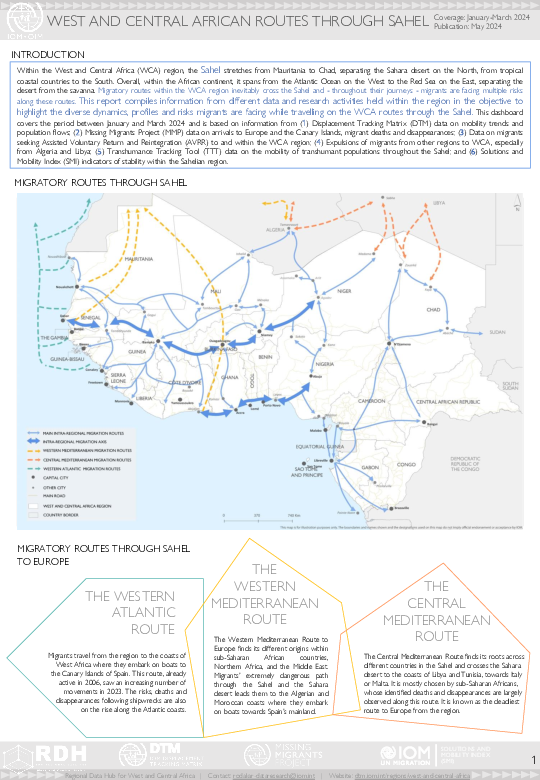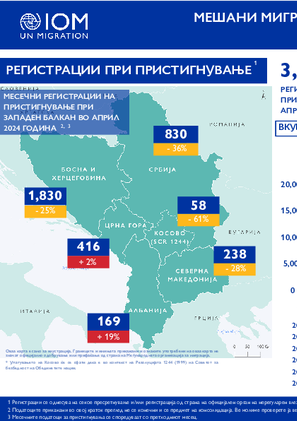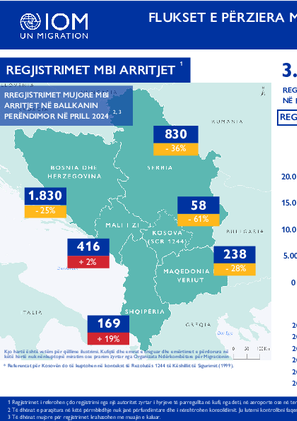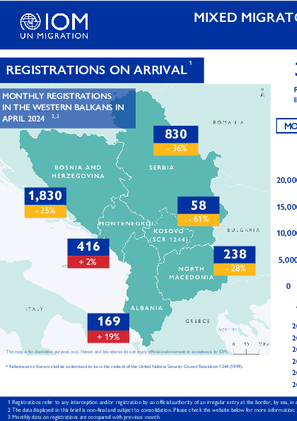-
Countries
-
Data and Analysis
-
Special Focus
-
Crisis Responses
Flow Monitoring
Domain host
migration.iom.int
Within the West and Central Africa (WCA) region, the Sahel stretches from Mauritania to Chad, separating the Sahara desert on the North, from tropical coastal countries to the South. Overall, within the African continent, it spans from the Atlantic Ocean on the West to the Red Sea on the East, separating the desert from the savanna. Migratory routes within the WCA region inevitably cross the Sahel and - throughout their journeys - migrants are facing multiple risks along these routes.
This report compiles information from different data and research activities held within the region in the objective to highlight the diverse dynamics, profiles and risks migrants are facing while travelling on the WCA routes through the Sahel. This dashboard covers the period between January and March 2024 and is based on information from (1) Displacement Tracking Matrix (DTM) data on mobility trends and population flows; (2) Missing Migrants Project (MMP) data on arrivals to Europe and the Canary Islands, migrant deaths and disappearances; (3) Data on migrants seeking Assisted Voluntary Return and Reintegration (AVRR) to and within the WCA region; (4) Expulsions of migrants from other regions to WCA, especially from Algeria and Libya; (5) Transhumance Tracking Tool (TTT) data on the mobility of transhumant populations throughout the Sahel; and (6) Solutions and Mobility Index (SMI) indicators of stability within the Sahelian region.
Месечен преглед на:
- Пристигнувања во Западен Балкан
- Топ три националности на лица кои пристигнале во месецот на известување
- Присуство на мигранти во прифатните објекти
- Доброволно асистирано враќање и реинтеграција
Mjesečni pregled:
- Dolasci na Zapadni Balkan
- Tri najzastupljenije nacionalnosti u izvještajnom mjesecu
- Prisustvo migranata u prihvatnim centrima
- Potpomognuti dobrovoljni povratak i reintegracija
Përmbledhje mujore të:
- Arritjet në Ballkanin Perëndimor
- Tre kombësitë kryesore të arriturëve
- Prania e migrantëve në qendrat pritëse
- Kthimet vullnetare dhe të asistuara
Monthly Overview of:
- Arrivals in the Western Balkans
- Top three nationalities at arrivals in the reporting month
- Migrants presence in reception facilities
- Assisted Voluntary Returns and reintegration

Contact
DTM Yemen, iomyemendtm@iom.int
Language
English
Location
Yemen
Period Covered
Jul 29 2023
Sep 20 2023
Activity
- Survey
- Displacement Solutions
- Mobility Tracking
- Baseline Assessment
This summary presents the findings of the second round of Area Assessment (mobility Tracking) undertaken by IOM’s Displacement Tracking Matrix in its new format to establish a new baseline on the number of Internally Displaced Persons (IDPs), IDP returnees, and migrants in Yemen.
Findings are currently limited to the country’s south controlled by the internationally recognized government (IRG). Data was collected by 154 enumerators through extensive network of Key Informants (KIs) within the operational area. DTM deployed enumerators who are in regular communication with the KIs network throughout each month and work continuously to maintain and expand this network to further triangulate the displacement statistics collected. DTM field staff, along with KIs, use the Sub-Area Assessment tool to capture locations, which are matched to identified locations in the OCHA’s Common Operational Dataset (P-Codes).
This round 4,512 KIs were interviewed to collect the data, of whom seven per cent or 295 were females and 93 per cent were male. In a total of 403 sub-districts, IOM recorded a presence of IDPs in 372 sub-districts (92%), a presence of IDP returnees in 209 sub-districts (52%) and a presence of migrants in 79 sub-districts (20%).
In the Yemen context, the practice for field teams is to select KIs representatives of both the host and target communities while adhering to the humanitarian principles of humanity, neutrality, impartiality, and operational independence. This ensures that the selected KIs are the most relevant and appropriate individuals to ensure the successful implementation of the exercise. Among the main outputs of the sub-Area Assessment is a list of locations where IDPs, returnees, and/or migrants are present that can be used to inform more detailed assessments at the locations level, including the annual Multi-Cluster Location Assessment (MCLA). Using a standardized and structured approach to the selection of KIs is a key step to ensuring that data collected in Sub-Area Assessment is comprehensive and comparable across the different teams. The Sub-Area Assessment tool is used to verify and update the baseline information in regular intervals (round).
IOM DTM implemented round 39 area assessment in coordination with the Ministry of Planning and International Cooperation Central (MoPIC), Statistical Organization (CSO), and Executive Unit for IDP Camps Management (ExU) in 13 governorates under the Government of Yemen. The number of migrants indicated in this report represents a snapshot in time for a transient population located in areas data collection teams could access.
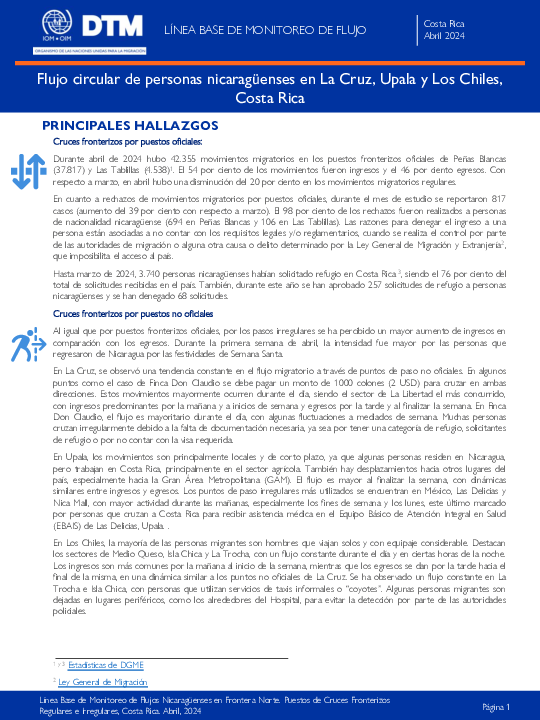
Contact
DTMCostaRica@iom.int
Language
English
Location
Costa Rica
Period Covered
Apr 01 2024
Apr 30 2024
Activity
- Flow Monitoring
- Baseline Assessment
La Organización Internacional para las Migraciones (OIM), como agencia de las Naciones Unidas en materia de migración en Costa Rica, implementó, desde 2021, dos rondas de la Matriz de Seguimiento al Desplazamiento (DTM por sus siglas en inglés) como parte de su estrategia de monitoreo del flujo migratorio circular de personas de nacionalidad nicaragüense, en puntos fronterizos no oficiales, en distintos cantones del norte del país. A partir de este ejercicio en tres puntos de ingreso no oficial de la frontera con Nicaragua, se contabilizaron 60 697 movimientos migratorios, de los cuales el 59 por ciento fueron egresos y 41 por ciento ingresos.
Siendo parte fundamental de la misión de OIM brindar asesoría clave sobre políticas y prácticas migratorias, se vuelve necesario actualizar los datos de este flujo migratorio circular de nicaragüenses que cruzan tanto de forma regular como irregular la frontera norte de Costa Rica.
Según los registros de la DGME de ingresos y egresos regulares por puestos fronterizos oficiales en Los Chiles y Peñas Blancas, en 2022 hubo 394.730 movimientos migratorios regulares (50 % ingresos y 50 % egresos) mientras que, durante el 2023, en total se registraron 526.271 movimientos migratorios (50 % ingresos y 50 % egresos), lo cual representó un aumento de 33 por ciento con respecto a 2022. Durante abril de 2024, se realizaron un total de 42.355 movimientos migratorios siendo el 54 por ciento egresos y el 46 por ciento egresos.
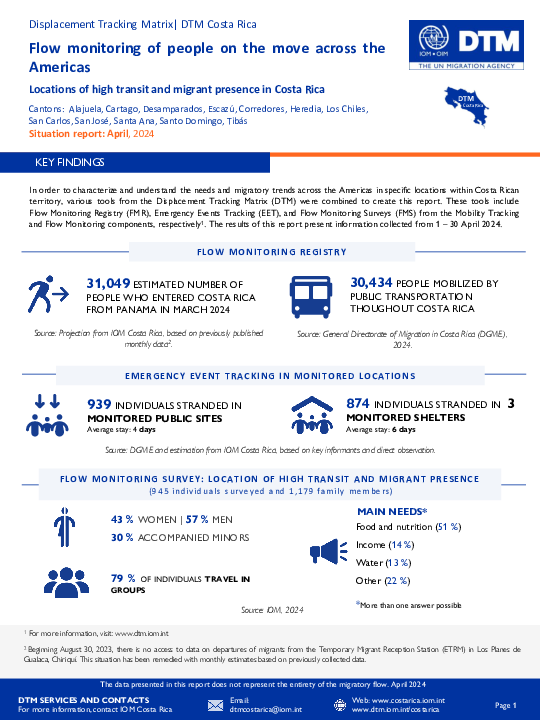
Contact
DTMCostaRica@iom.int
Language
English
Location
Costa Rica
Period Covered
Apr 01 2024
Apr 30 2024
Activity
- Flow Monitoring
- Mobility Tracking
- Event Tracking
Cantons: Alajuela, Alajuelita, Cartago, Desamparados, Escazú, Corredores, Heredia, Los Chiles, San Carlos, San José, Santa Ana, Santo Domingo, Tibás
Costa Rica, like the other countries in the Central American region, has been characterized as a migratory corridor for people who transit by land from the south to the north of America and whose destination is the countries in the north of the continent. This flow on the move through the Americas is mainly made up of people from the Bolivarian Republic of Venezuela, Cuba, Haiti, Ecuador, as well as people from other countries in South America, Africa and Asia.
According to estimations from IOM Costa Rica, during April 31,049 people entered the country, an approximate average of 1,035 people per day and estimating a decrease of 14% compared to March 2024. In addition, 874 people stranded in the monitored shelters were identified and 939 people stranded in the public places visited.
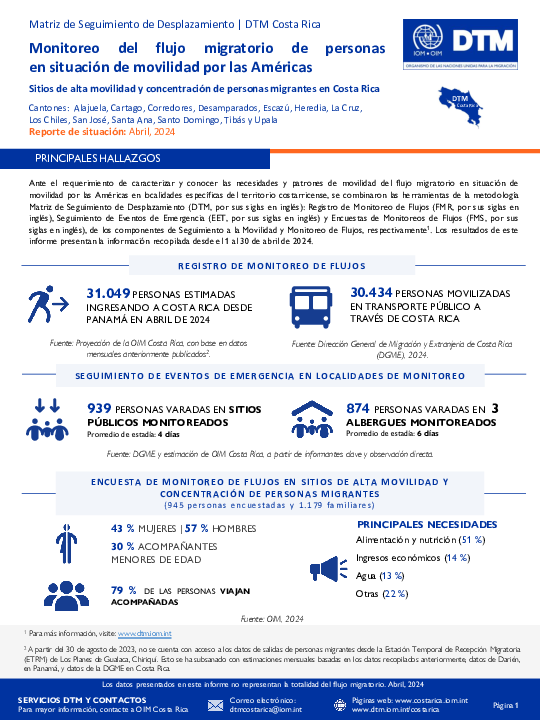
Contact
Angélica Madrigal amadrigal@iom.int
Language
English
Location
Costa Rica
Period Covered
Apr 01 2024
Apr 30 2024
Activity
- Survey
- Registration
- Flow Monitoring
Cantones: Alajuela, Alajuelita, Cartago, Desamparados, Escazú, Corredores, Heredia, Los Chiles, San Carlos, San José, Santa Ana, Santo Domingo, Tibás
Costa Rica, al igual que los demás países de la región centroamericana, se ha caracterizado por ser un corredor migratorio para personas que transitan de manera terrestre desde el sur hasta el norte de América y que tienen como destino los países del norte del continente. Este flujo en situación de movilidad por las Américas se encuentra compuesto principalmente por personas de la República Bolivariana de Venezuela, Cuba, Haití, Ecuador, así como personas provenientes de otros países de Suramérica, África y Asia.
Según estimaciones de la OIM Costa Rica, durante abril ingresaron al país 31.049 personas, un promedio aproximado de 1.035 personas por día y estimando una disminución de un 14% con respecto a marzo de 2024. Además, se identificaron 874 personas varadas en los albergues monitoreados y 939 personas varadas en los sitios públicos visitados.
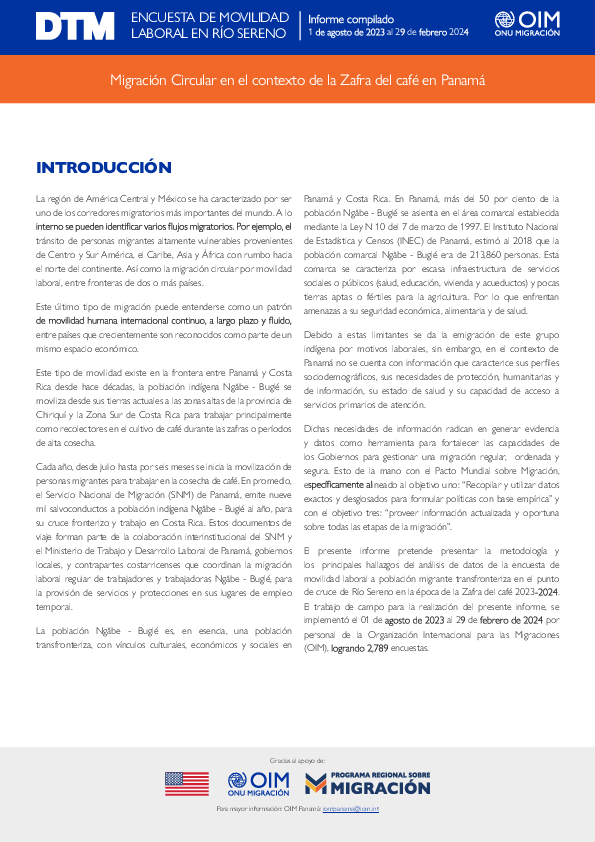
Contact
iompanama@iom.int
Language
Spanish
Location
Panama
Period Covered
Aug 01 2023
Feb 29 2024
Activity
- Survey
a región de América Central y México se ha caracterizado por ser uno de los corredores migratorios más importantes del mundo. A lo interno se pueden identificar varios flujos migratorios. Por ejemplo, el tránsito de personas migrantes altamente vulnerables provenientes de Centro y Sur América, el Caribe, Asia y África con rumbo hacia el norte del continente. Así como la migración circular por movilidad laboral, entre fronteras de dos o más países.
Este último tipo de migración puede entenderse como un patrón de movilidad humana internacional continuo, a largo plazo y fluido, entre países que crecientemente son reconocidos como parte de un mismo espacio económico.
Este tipo de movilidad existe en la frontera entre Panamá y Costa Rica desde hace décadas, la población indígena Ngäbe - Buglé se moviliza desde sus tierras actuales a las zonas altas de la provincia de Chiriquí y la Zona Sur de Costa Rica para trabajar principalmente como recolectores en el cultivo de café durante las zafras o períodos de alta cosecha.
Cada año, desde julio hasta por seis meses se inicia la movilización de personas migrantes para trabajar en la cosecha de café. En promedio, el Servicio Nacional de Migración (SNM) de Panamá, emite nueve mil salvoconductos a población indígena Ngäbe - Buglé al año, para su cruce fronterizo y trabajo en Costa Rica. Estos documentos de viaje forman parte de la colaboración interinstitucional del SNM y el Ministerio de Trabajo y Desarrollo Laboral de Panamá, gobiernos locales, y contrapartes costarricenses que coordinan la migración laboral regular de trabajadores y trabajadoras Ngäbe - Buglé, para la provisión de servicios y protecciones en sus lugares de empleo temporal.
Pagination
- Previous page
- Page 9
- Next page
